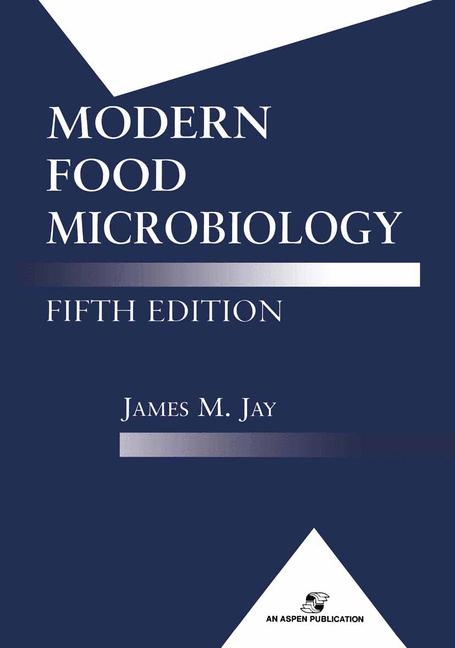
Modern Food Microbiology
Springer-Verlag New York Inc.
978-1-4615-7478-1 (ISBN)
- Titel wird leider nicht erscheinen
- Artikel merken
I Historical Background.- 1 History of Microorganisms in Food.- Historical developments.- Food preservation.- Food spoilage.- Food poisoning.- Food legislation.- II Habitats, Taxonomy, and Growth Parameters.- 2 Taxonomy, Role, and Significance of Microorganisms in Foods.- Bacterial taxonomy.- rRNA analyses.- Analysis of DNA.- Primary sources of microorganisms found in foods.- Synopsis of common foodborne bacteria.- Synopsis of common genera of foodborne molds.- Synopsis of common genera of foodborne yeasts.- 3 Intrinsic and Extrinsic Parameters of Foods that Affect Microbial Growth.- Intrinsic parameters.- pH.- pH effects.- Moisture content.- Effect of low aw.- Oxidation-reduction potential.- Eh effects.- Nutrient content.- Antimicrobial constituents.- Lactoperoxidase system.- Biological structure.- Extrinsic parameters.- Temperature of storage.- Relative humidity of environment.- Presence and concentration of gases in environment.- Effect of CO2 and O2.- Presence and activities of other microorganisms.- General microbial interference.- Lactic antagonism.- Combined intrinsic and extrinsic parameters: The hurdle concept.- III Microorganisms in Foods.- 4 Fresh Meats and Poultry.- Biochemical events that lead to rigor mortis.- The biota of meats and poultry.- Incidence and prevalence of microorganisms in fresh red meats.- Soy-extended ground meats.- Mechanically deboned meat, poultry, and fish.- Hot-boned meats.- Effect of electrical stimulation.- Organ and variety meats.- Microbial spoilage of fresh red meats.- Mechanism.- Spoilage of fresh livers.- Incidence/prevalence of microorganisms in fresh poultry.- Microbial spoilage of poultry.- Carcass sanitizing/washing.- 5 Processed Meats and Poultry.- Modified-atmosphere-packaged and vacuum-packaged meats.- Vacuum packaging and CO2 effects.- Spoilage of MAP and vacuum-packaged meats 101 Volatile components of vacuum-packaged meats and poultry.- Sausages, bacon, bologna, and related meat products.- Spoilage.- Bacon and cured hams.- Fermented meat products.- 6 Seafoods.- Microbiological quality of various fresh and frozen products.- Fermented fish products.- Spoilage of fish and shellfish.- Fish.- Shellfish.- Crustaceans.- Mollusks.- 7 Fermentation and Fermented Dairy Products.- Fermentation.- Background.- Defined and characterized.- The lactic acid bacteria.- Metabolic pathway and molar growth yields.- Dairy Products.- Milk biota.- Starter cultures, products.- Cheeses.- Apparent health benefits of fermented foods.- Lactose intolerance.- Cholesterol.- Anticancer effects.- Diseases caused by lactic acid bacteria.- 8 Fresh and Fermented Fruit and Vegetable Products.- Fresh and frozen vegetables.- Spoilage.- Bacterial agents.- Bacterial soft rot.- Other bacterial spoilage conditions.- Fungal agents.- Gray mold rot.- Sour rot (oospora rot, watery soft rot).- Rhizopus soft rot.- Phytophora rot.- Anthracnose.- Spoilage of fruits.- Fermented Products.- Breads.- Olives, pickles, and sauerkraut.- Beer, ale, wines, cider, and whiskeys.- Miscellaneous fermented products.- 9 Miscellaneous Food Products.- Delicatessen and related foods.- Eggs.- Mayonnaise and salad dressings.- Cereals, flour, and dough products.- Bakery products.- Frozen meat pies.- Sugars, candies, and spices.- Nutmeats.- Dehydrated foods.- Enteral nutrient solutions (medical foods).- Single-cell protein.- Rationale for SCP production.- Organisms and fermentation substrates.- SCP products.- The nutrition and safety of SCP.- IV Determining Microorganisms and/or Their Products in Foods.- 10 Culture, Microscopic, and Sampling Methods.- Conventional SPC.- Homogenization of food samples.- The spiral plater.- Membrane filters.- Direct epifluorescent filter technique.- Microcolony-DEFT.- Hydrophobic grid membrane filter.- Microscope colony counts.- Agar droplets.- Dry films.- Most probable numbers.- Dye reduction.- Roll tubes.- Direct microscopic count.- Howard mold count.- Microbiological examination of surfaces.- Swab/swab-rinse methods.- Contact plate.- Agar syringe/"agar sausage" methods.- Other surface methods.- Direct surface.- Sticky film.- Swab/agar slant.- Ultrasonic devices.- Spray gun.- Metabolically injured organisms.- Recovery/repair.- Mechanism.- Viable but nonculturable organisms.- 11 Physical, Chemical, Molecular, and Immunologic Methods.- Physical Methods.- Impedance and related.- Microcalorimetry.- Flow cytometry.- Chemical methods.- Thermostable nuclease.- Limulus lysate for endotoxins.- Adenosine-triphosphate measurement.- Radiometry.- Fluorogenic and chromogenic substrates.- Lux gene luminescence.- Methods for characterizing and fingerprinting foodborne organisms.- Serotyping.- Bacteriophage typing.- Nucleic acid (DNA) probes.- DNA amplification (polymerase chain reaction).- Multilocus enzyme electrophoresis typing.- Restriction enzyme analysis.- Random amplification of polymorphic DNA.- Pulsed field gel electrophoresis.- Restriction fragment length polymorphism.- Ribotyping.- Immunologic methods.- Fluorescent antibody.- Enrichment serology.- Salmonella 1-2 test.- Radioimmunoassay.- ELISA.- Salmonellae.- S. aureus and its enterotoxins.- Molds and mycotoxins.- Botulinal Toxins.- E. coli enterotoxins.- Gel diffusion.- Hemagglutination.- 12 Bioassay and Related Methods.- Whole-Animal Assays.- Mouse lethality.- Suckling (infant) mouse.- Rabbit and mouse diarrhea.- Monkey feeding.- Kitten (cat) test.- Rabbit and guinea pig skin tests.- Sereny and Anton tests.- Animal models requiring surgical procedures.- Ligated loop techniques.- The Ritard model.- Cell culture systems.- Human mucosal cells.- Human fetal intestine.- Human ileal and intestinal cells.- Guinea pig intestinal cells.- HeLa cells.- Chinese hamster ovary cells.- Vero cells.- Y-1 adrenal cell assay.- Other assays.- V Food Preservation and Some Properties of Psychrotrophs, Thermophiles, and Radiation-Resistant Bacteria.- 13 Food Preservation with Chemicals.- Benzoic acid and the parabens.- Sorbic acid.- The propionates.- Sulfur dioxide and sulfites.- Nitrites and nitrates.- Organisms affected.- The Perigo factor.- Interaction with cure ingredients and other factors.- Nitrosamines.- Nitrite-sorbate and other nitrite combinations.- Mode of action.- Summary of nitrite effects.- NaCl and sugars.- Indirect antimicrobials.- Antioxidants.- Flavoring agents.- Spices and essential oils.- Medium-chain fatty acids and esters.- Acetic and lactic acids.- Antibiotics.- Nisin.- Natamycin.- Tetracyclines.- Subtilin.- Tylosin.- Antifungal agents for fruits.- Ethylene and propylene oxides.- Miscellaneous chemical preservatives.- 14 Radiation Preservation of Foods and Nature of Microbial Radiation Resistance.- Characteristics of radiations of interest in food preservation.- Ultraviolet light.- Beta rays.- Gamma rays.- X rays.- Microwaves.- Principles underlying the destruction of microorganisms by irradiation.- Types of organisms.- Numbers of organisms.- Composition of suspending menstrum (food).- Presence or absence of oxygen.- Physical state of food.- Age of organisms.- Processing of foods for irradiation.- Selection of foods.- Cleaning of foods.- Packing.- Blanching or heat treatment.- Application of radiation.- Gamma radiation.- Electron beams/accelerated electrons.- Radappertization, radicidation, and radurization of foods.- Radappertization.- Radicidation.- Radurization.- Legal status of food irradiation.- Effect of irradiation on food quality.- Storage stability of irradiated foods.- Nature of radiation resistance of microorganisms.- Biology of extremely resistant species.- Apparent mechanisms of resistance.- 15 Low-Temperature Food Preservation and Characteristics of Psychrotrophic Microorganisms.- Definitions.- Temperature growth minima.- Preparation of foods for freezing.- Freezing of foods and freezing effects.- Storage stability of frozen foods.- Effect of freezing on microorganisms.- Effect of thawing.- Some characteristics of psychrotrophs and psychrophiles.- The effect of low temperatures on microbial physiologic mechanisms.- Nature of the low heat resistance of psychrotrophs.- 16 High-Temperature Food Preservation and Characteristics of Thermophilic Microorganisms.- Factors affecting heat resistance in microorganisms.- Relative heat resistance of microorganisms.- Spore resistance.- Thermal destruction of microorganisms.- Manothermosonication (thermo-ultrasonication).- Aseptic packaging.- Some characteristics of thermophiles.- Enzymes.- Ribosomes.- Flagella.- Other aspects of thermophilic microorganisms.- Canned food spoilage.- 17 Preservation of Foods by Drying.- Preparation and drying of low-moisture foods.- Effect of drying on microorganisms.- Storage stability of dried foods.- Intermediate-moisture foods.- Preparation of IMF.- Microbial aspects of IMF.- Storage stability of IMF.- IMF and glass transition.- VI Microbial Indicators of Food Safety and Quality, Principles of Quality Control, and Microbiological Criteria.- 18 Indicators of Food Microbial Quality and Safety.- Indicators of product quality.- Indicators of food safety.- Coliforms.- Strains.- Growth.- Detection and enumeration.- Distribution.- Coliform criteria and standards.- Some limitations for food safety use.- Enterococci.- Historical background.- Classification and growth requirements.- Distribution.- Relationship to sanitary quality of foods.- Bifidobacteria.- Distribution.- Coliphages.- Utility for water.- Utility for foods.- Predictive microbiology/microbial modeling.- 19 The Haccp System and Food Safety.- Hazard Analysis Critical Control Point system.- Definitions.- HACCP principles.- Principle 1.- Principle 2.- Principle 3.- Principle 4.- Principle 5.- Principle 6.- Principle 7.- Flow diagrams.- Some limitations of HACCP.- Microbiological criteria.- Definitions.- Sampling plans.- Microbiological criteria and food safety.- Microbiological criteria for various products.- Other criteria/guidelines.- VII Foodborne Diseases.- 20 Staphylococcal Gastroenteritis.- Species of concern in foods.- Habitat and distribution.- Incidence in foods.- Nutritional requirements for growth.- Temperature growth range.- Effect of salts and other chemicals.- Effect of pH, aw, and other parameters.- NaCl and pH.- pH, aw, and temperature.- NaNO2, Eh, pH, and temperature of growth.- Staphylococcal enterotoxins: Types and incidence.- Chemical and physical properties.- Production.- Mode of action.- The gastroenteritis syndrome.- Incidence and vehicle foods.- Ecology of S. aureus growth.- Prevention of staphylococcal and other food-poisoning syndromes.- 21 Food Poisoning Caused by Gram-Positive Sporeforming Bacteria.- Clostridium perfringens food poisoning.- Distribution of C. perfringens.- Characteristics of the organism.- The enterotoxin.- Mode of action.- Vehicle foods and symptoms.- Prevention.- Botulism.- Distribution of C. botulinum.- Growth of C. botulinum strains.- Ecology of C. botulinum growth.- Concerns for sous vide and related food products.- Nature of the botulinal neurotoxins (BoNT).- The adult botulism syndrome: Incidence and vehicle foods.- Infant botulism.- Bacillus cereus gastroenteritis.- B. cereus toxins.- Diarrheal syndrome.- Emetic syndrome.- 22 Foodborne Listeriosis.- Taxonomy of Listeria.- Serotypes.- Subspecies typing.- Growth.- Effect of pH.- Combined effect of pH and NaCl.- Effect of temperature.- Effect of aw.- Distribution.- The Environment.- Foods and humans.- Prevalence.- Thermal properties.- Dairy products.- Nondairy products.- Effect of sublethal heating on thermotolerance.- Virulence properties.- Listeriolysin O and ivanolysin O.- Intracellular invasion.- Monocytosis-producing activity.- Sphingomyelinase.- Animal models and infectious dose.- Incidence and nature of the listeriosis syndromes.- Incidence.- Source of pathogens.- Syndromes.- Resistance to listeriosis.- Persistence of L. monocytogenes in foods.- Regulatory status of L. monocytogenes in foods.- 23 Foodborne Gastroenteritis Caused by Salmonella and Shigella.- Salmonellosis.- Serotyping of Salmonella.- Distribution of Salmonella.- Animal feeds.- Food products.- Growth and destruction of salmonellae.- The Salmonella food-poisoning syndrome.- Salmonella toxins and virulence properties.- Incidence and vehicle foods.- Prevention and control of salmonellosis.- Competitive exclusion to reduce salmonellae carriage in poultry.- Shigellosis.- Foodborne cases.- Virulence properties.- 24 Foodborne Gastroenteritis Caused by Escherichia coli.- Serologic classification.- The recognized virulence groups.- Enteroaggregative (EAggEC).- Enterohemorrhagic (EHEC).- The toxins.- Growth and Stx production.- Effect of environmental and physical agents.- Prevalence in foods.- Prevalence in dairy cattle.- Human disease syndromes/prevalence.- Enteroinvasive (EIEC).- Enteropathogenic (EPEC).- Enterotoxigenic (ETEC).- The enterotoxins.- Prevention.- Travelers' diarrhea.- 25 Foodborne Gastroenteritis Caused by Vibrio, Yersinia, and Campylobacter Species.- Vibriosis (Vibrio parahaemolyticus).- Growth conditions.- Virulence properties.- Gastroenteritis syndrome and vehicle foods.- Other Vibrios.- Vibrio cholerae.- Vibrio vulnificus.- Vibrio alginolyticus and V. hollisae.- Yersiniosis (Yersinia enterocolitica).- Growth requirements.- Distribution.- Serovars and biovars.- Virulence factors.- Incidence of Y. enterocolitica in foods.- Gastroenteritis syndrome and incidence.- Campylobacteriosis (Campylobacter jejuni).- Distribution.- Virulence properties.- Enteritis syndrome.- Prevention.- 26 Foodborne Animal Parasites.- Protozoa.- Giardiasis.- Environmental distribution.- Syndrome, diagnosis, and treatment.- Incidence in foods and foodborne cases.- Amebiasis.- Syndrome, diagnosis, and treatment.- Toxoplasmosis.- Symptoms, diagnosis, and treatment.- Distribution of T. gondii.- Food-associated cases.- Control.- Sarcocystosis.- Cryptosporiodiosis.- Symptoms, diagnosis, and treatment.- Waterborne and foodborne outbreaks.- Flatworms.- Fascioliasis.- Symptoms, diagnosis, and treatment.- Fasciolopiasis.- Paragonimiasis.- Symptoms, diagnosis, and treatment.- Clonorchiasis.- Symptoms, diagnosis, treatment, and prevention.- Diphyllobothriasis.- Prevalence.- Symptoms, diagnosis, and treatment.- Prevention.- Cysticercosis/taeniasis.- Symptoms, diagnosis, and treatment.- Prevention.- Roundworms.- Trichinosis.- Prevalence.- Symptoms and treatment.- Diagnosis.- Prevention and control.- Microwave cooking.- Anisakiasis.- Symptoms, diagnosis, and treatment.- Prevalence and distribution.- Prevention.- 27 Mycotoxins.- Anatoxins.- Requirements for growth and toxin production.- Production and occurrence in foods.- Relative toxicity and mode of action.- Degradation.- Alternaria toxins.- Citrinin.- Ochratoxins.- Patulin.- Penicillic acid.- Sterigmatocystin.- Fumonisins.- Growth and production.- Prevalence in corn and foods.- Physical/chemical properties of FB1 and FB2.- Pathology.- Sambutoxin.- Zearalenone.- 28 Viruses and Other Foodborne Biohazards.- Viruses.- Incidence in foods and the environment.- Destruction in foods.- Hepatitis A virus.- Norwalk and related viruses.- Rotaviruses.- Histamine-associated (Scombroid) poisoning.- Paralytic shellfish poisoning.- Aeromonas, Plesiomonas, and Bacteroides.- Aeromonas.- Plesiomonas.- Bacteroides fragilis.
| Erscheinungsdatum | 20.12.2018 |
|---|---|
| Reihe/Serie | Food Science Texts Series |
| Verlagsort | New York, NY |
| Sprache | englisch |
| Themenwelt | Naturwissenschaften ► Biologie ► Mikrobiologie / Immunologie |
| Technik ► Lebensmitteltechnologie | |
| Schlagworte | Chemistry • Food • Food Microbiology • Microbiology • Microorganism |
| ISBN-10 | 1-4615-7478-1 / 1461574781 |
| ISBN-13 | 978-1-4615-7478-1 / 9781461574781 |
| Zustand | Neuware |
| Haben Sie eine Frage zum Produkt? |
aus dem Bereich


